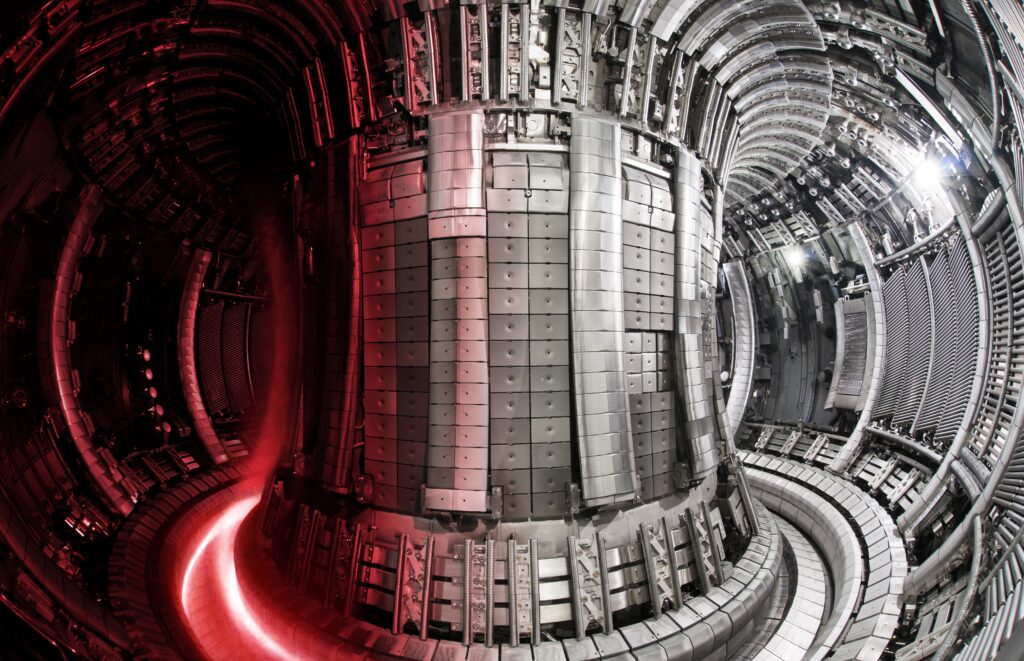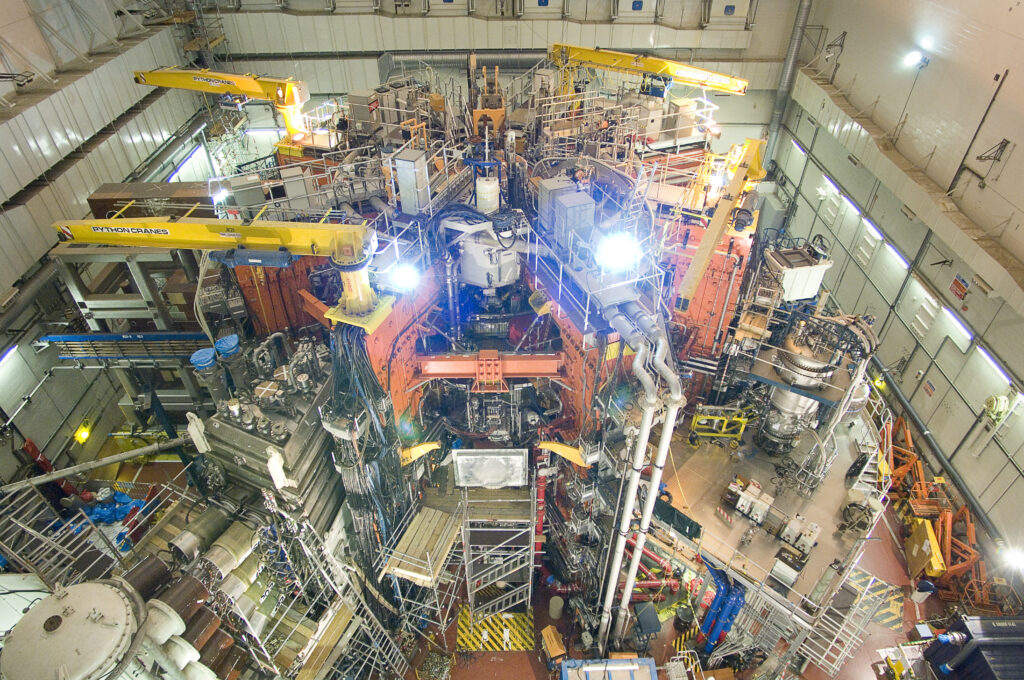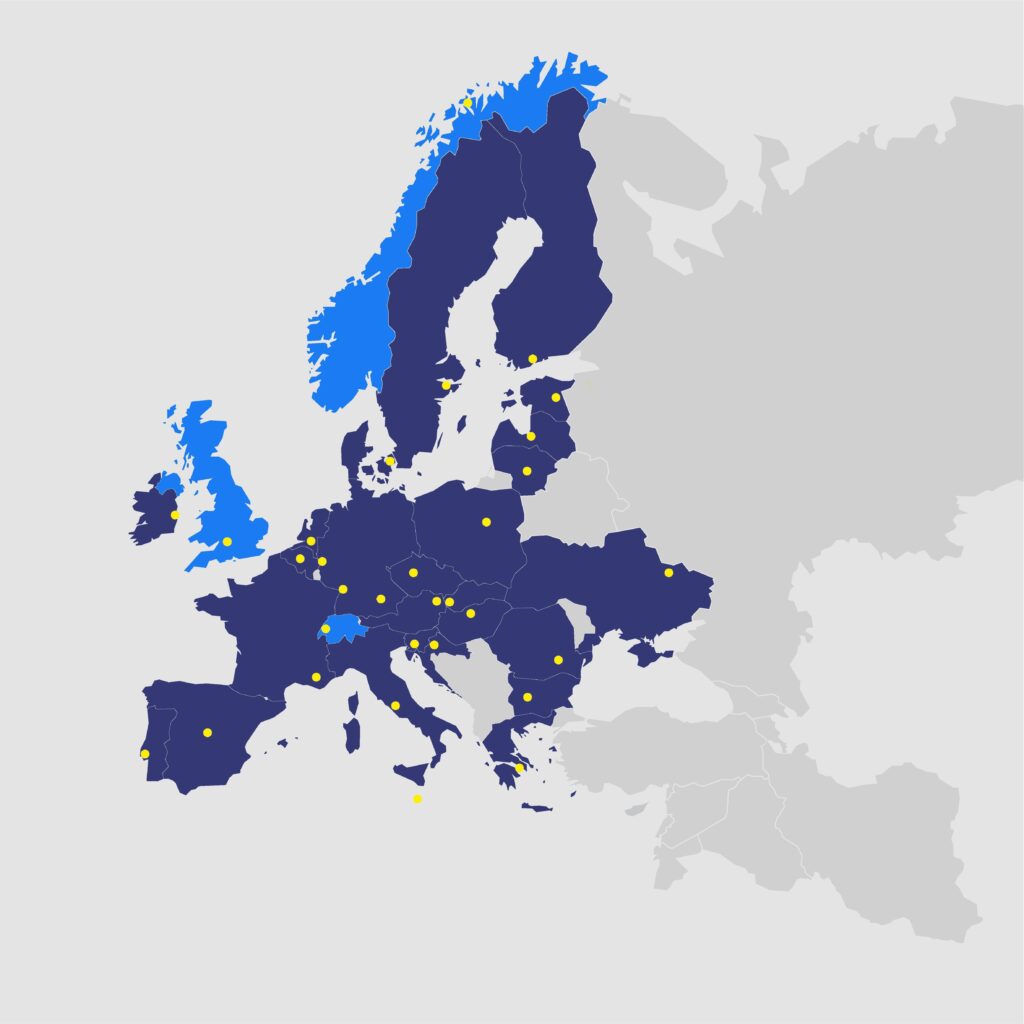In 2021, the EUROfusion consortium of fusion laboratories around Europe ran a dedicated experimental campaign at the Joint European Torus facility (JET) in Culham, UK. The European consortium designed these experiments to explore the extreme conditions expected in the international ITER fusion energy research project and the fusion power plants to follow.
The researchers reached conditions including temperatures of 150 million degrees Celsius inside the donut-shaped cloud of plasma (hot, charged gas) that is suspended inside JET’s magnetic field cage.
“One of our most eye-catching results is the first direct observation of the fusion fuel keeping itself hot through alpha heating. This is the process where high-energy helium ions (alpha particles) coming out of the fusion reaction transfer their heat to the surrounding fuel mix to keep the fusion process going”, says Costanza Maggi, a UKAEA Fellow and former JET Task Force Leader. “Studying this process under realistic conditions is crucial to developing fusion power plants.”

First look at alpha heating and other results
The results presented by the EUROfusion researchers will prove crucial to inform the design and operation of future fusion experimental machines running on deuterium-tritium (a mix of two hydrogen isotopes used to produce fusion energy) fuel. Most of the results have been published in a special issue of the scientific journal Nuclear Fusion, with the work on alpha heating [updated link] appearing in the prestigious scientific journal Physical Review Letters.

- The first direct observations of alpha heating, where the high-energy helium ions (alpha particles) produced by fusion reactions keep the surrounding fuel mix hot enough without disturbing fusion conditions.
- A successful demonstration of a control technique to protect the walls of the exhaust system. This divertor is the only part of a tokamak (a donut-shaped device used to confine hot plasma) that comes into direct contact with the hot fuel and needs to withstand more intense conditions than spaceships re-entering Earth’s atmosphere.
- The experiments confirmed predictions from advanced computer models for heat transport inside the plasma, which are crucial to extrapolate results from current experimental setups to larger future machines like ITER and the demonstration fusion power plant DEMO.
- Successful tests of methods to recover tritium fuel that has been absorbed by the interior metal wall of the tokamak. Efficient recovery of tritium is key to the operation and end-of-life decommissioning of fusion machines.
- Verified a heating technique planned for the ITER project to deposit external heating exactly where needed. The demonstration gives confidence in the design and planned operation of the international fusion project ITER.
Record-setting experiments
JET is the only operating fusion machine of the tokamak design that can produce large amounts of fusion reactions, because of its unique capability to operate with the fuel mix deuterium-tritium. This is the high-performance fuel mix planned for the international ITER project and the future European demonstration fusion power plant DEMO.
The second deuterium-tritium experimental campaign (DTE2) at JET in 2021 set a world record of 59 megajoules for the most fusion heat produced in a single shot, which received great public interest when announced in February 2022.
Volker Naulin, Head of the EUROfusion Fusion Science Department, said:
“The DTE2 campaign has been prepared by EUROfusion researchers over many years. The scientific results and the energy record achieved at JET in 2021 show that we understand and control fusion plasma under conditions as close to those in future fusion devices as we can get. We predicted and finally showed that we can produce, maintain, and study fusion under high-performance conditions, for as long as the machine allows. This confirms that we are on the right path to fusion energy to the grid.”
Ambrogio Fasoli, Director of the Swiss Plasma Center and Programme Manager-elect of EUROfusion, said:
“The JET DTE2 campaign has enriched the formidable knowledge on magnetic fusion that’s provided the basis for the operation of ITER operation. It will also help guide the development of DEMO, which is the backbone device of the European strategy towards fusion power plants. The scientific results included work on plasma conditions and materials compatible with power plants and crucial information for the overall European strategy. They provide a crucial basis for a safe approach to burning plasma in ITER.”
Fernanda Rimini, JET Senior Exploitation Manager (UKAEA), said:
“The foundations of the JET success lie in the vision, ambition and exceptional combination of physics and engineering talent of the design team: they produced a device with unique characteristics for the times, namely size and D-T capability, but they also fostered an environment rewarding the dialogue and tight integration between physics and engineering. The tradition of excellence was continued by the JET Team, working over the last 40 years to advance fusion research.”

40 years of fusion science
JET is the largest and most successful fusion experiment in the world, and a central research facility of the European Fusion Programme. JET is based at the UKAEA campus in Culham, UK and is collectively used by more than 31 European laboratories under the management of the EUROfusion consortium—experts, students, and staff from across Europe, co-funded by the European Commission.
Fusion researchers across Europe and beyond celebrated the 40th anniversary of JET’s first plasma shot on Sunday 25 June this year. Since its inception in 1983, JET has been at the forefront of groundbreaking achievements, spearheading the pursuit of safe, low-carbon, and sustainable fusion energy solutions to meet the world’s future energy demands.
Over its lifetime, JET has delivered crucial insights into the complex mechanics of fusion, allowing scientists to plan the international fusion experiment ITER and DEMO, the demonstration fusion power plant currently under design by the European fusion community.

Fusion energy’s potential
Fusion, the process that powers stars like our sun, promises a near-limitless clean baseload electricity source for the long term, using small amounts of fuel that can be sourced worldwide from inexpensive materials. The fusion process brings together atoms of light elements like hydrogen at high temperatures to form helium and release tremendous energy as heat. Fusion is inherently safe in that it cannot start a run-away process and produces no long-lived waste.
Scientific publications
The result on alpha heating was published in the scientific journal Physical Review Letters:
https://journals.aps.org/prl/abstract/10.1103/PhysRevLett.131.075101 [updated link]
Other results from the experimental campaign were published in a special issue of the scientific journal Nuclear Fusion:
https://iopscience.iop.org/issue/0029-5515/63/11
Contact
For media enquiries, further information and interview requests, please contact:
EUROfusion – the European Consortium for the Development of Fusion Energy
About EUROfusion
EUROfusion is a consortium of 31 research organisations, and behind them around 164 affiliated entities including universities and companies, from 29 European countries. Together they work towards a facility that can deliver fusion electricity to the power grid in accordance with the European Research Roadmap to the Realisation of Fusion Energy.
The EUROfusion programme has two aims: preparing for ITER experiments and developing concepts for the future European demonstration fusion power plant DEMO. Other facets of the EUROfusion programme are to support diverse research projects in participating laboratories through the Enabling Research scheme and to train the new generation of fusion scientists and engineers via its prestigious grant programme.
For more information: https://www.euro-fusion.org, LinkedIn, X
